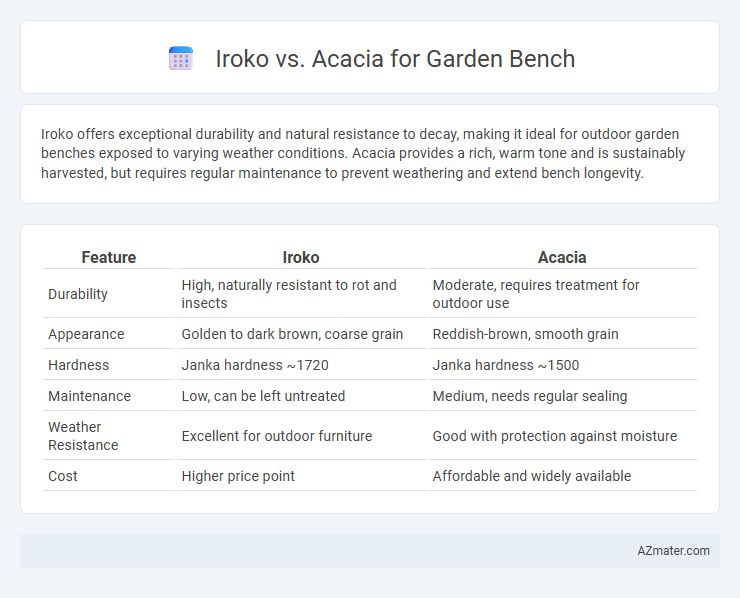Iroko offers exceptional durability and natural resistance to decay, making it ideal for outdoor garden benches exposed to varying weather conditions. Acacia provides a rich, warm tone and is sustainably harvested, but requires regular maintenance to prevent weathering and extend bench longevity.
Table of Comparison
| Feature | Iroko | Acacia |
|---|---|---|
| Durability | High, naturally resistant to rot and insects | Moderate, requires treatment for outdoor use |
| Appearance | Golden to dark brown, coarse grain | Reddish-brown, smooth grain |
| Hardness | Janka hardness ~1720 | Janka hardness ~1500 |
| Maintenance | Low, can be left untreated | Medium, needs regular sealing |
| Weather Resistance | Excellent for outdoor furniture | Good with protection against moisture |
| Cost | Higher price point | Affordable and widely available |
Introduction to Iroko and Acacia Woods
Iroko wood, native to West Africa, is prized for its durability, natural resistance to decay, and rich golden to brown hues, making it an excellent choice for outdoor garden benches. Acacia wood, sourced primarily from Australia and Africa, offers a dense, hard texture and attractive grain patterns with warm reddish to brown tones, well-suited for weather-resistant garden furniture. Both woods provide robust strength and natural oils that enhance longevity, but Iroko's slightly higher resistance to moisture and pests makes it ideal for long-term outdoor use.
Key Characteristics of Iroko Wood
Iroko wood is prized for its exceptional durability, resistance to rot, and natural oils that protect against insects, making it ideal for outdoor garden benches. This hardwood features a coarse texture with a golden to medium brown color that weathers to a rich silver-gray, maintaining its structural integrity over time. Compared to Acacia, Iroko offers superior stability and longevity in harsh weather conditions, ensuring a low-maintenance and long-lasting garden bench.
Key Characteristics of Acacia Wood
Acacia wood is renowned for its rich color variations, ranging from golden brown to deep reddish hues, making it visually appealing for garden benches. Its dense grain and natural oils provide significant resistance to moisture, decay, and insect damage, enhancing durability in outdoor settings. Acacia's sustainability and affordability offer an eco-friendly and cost-effective alternative without compromising strength and aesthetic quality.
Weather Resistance: Iroko vs Acacia
Iroko wood offers exceptional weather resistance due to its natural oils that protect against moisture, decay, and insect damage, making it ideal for outdoor garden benches in humid and rainy climates. Acacia is also durable and weather-resistant but requires regular sealing and maintenance to prevent cracking and discoloration from prolonged sun and rain exposure. Overall, Iroko provides superior longevity with minimal upkeep compared to Acacia, which benefits from its affordability and stunning grain when properly maintained.
Durability and Longevity Comparison
Iroko wood exhibits exceptional durability and natural resistance to rot, decay, and insect infestations, making it ideal for outdoor garden benches exposed to fluctuating weather conditions. Acacia, while also durable and resistant to moisture, typically requires regular maintenance and sealing to prolong its lifespan in outdoor settings. Iroko's superior density and oil content contribute to a longer lifespan, often outlasting Acacia by several years in similar environmental conditions.
Maintenance Requirements for Each Wood
Iroko requires minimal maintenance due to its natural oil content, which resists rot and insect damage, making it ideal for garden benches exposed to moisture. Acacia demands regular sealing or oiling to prevent cracking and fading from UV exposure, ensuring long-lasting durability and appearance. Both woods benefit from occasional cleaning, but Iroko's low upkeep makes it a preferred choice for low-maintenance outdoor furniture.
Aesthetics and Color Variations
Iroko wood offers a rich golden to medium brown hue that darkens with age, providing a warm and luxurious aesthetic ideal for garden benches. Acacia wood presents a broader palette, ranging from light amber to deep reddish-brown, showcasing natural grain patterns that enhance outdoor rustic charm. Both woods feature unique textures and color variations that can complement diverse garden styles, but Iroko's consistent hues contrast with Acacia's more dynamic, contrasting tones.
Cost and Value Considerations
Iroko wood generally costs more than Acacia due to its durability and resistance to weathering, making it a long-term investment for garden benches. Acacia offers a more affordable option with decent durability but may require more frequent maintenance to retain its value. Choosing Iroko provides better cost efficiency over time, while Acacia suits budget-conscious buyers seeking initial savings.
Sustainability and Sourcing Issues
Iroko wood offers moderate sustainability with responsible harvesting primarily in West Africa, but concerns arise due to limited certification and illegal logging practices. Acacia, often sourced from fast-growing plantations, presents a more sustainable option with quicker renewability and better certification availability. Choosing acacia for garden benches generally supports eco-friendly sourcing and lower environmental impact compared to iroko, which requires careful supplier verification.
Which Wood is Best for Your Garden Bench?
Iroko offers exceptional durability and natural resistance to decay, making it ideal for outdoor garden benches exposed to harsh weather conditions. Acacia provides a rich, warm color and high density, delivering both strength and aesthetic appeal but may require regular maintenance to prevent weathering. Choosing between Iroko and Acacia depends on your preference for longevity with minimal upkeep or a more vibrant appearance with routine care for your garden bench.

Infographic: Iroko vs Acacia for Garden Bench
 azmater.com
azmater.com